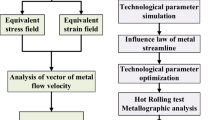Abstract
During the hot forging process, the shaping property and forging quality will fluctuate because of die wear, manufacturing tolerance, dimensional variation caused by temperature and the different friction conditions, etc. In order to control this variation in performance and to optimize the process parameters, a robust design method is proposed in this paper, based on the finite element method for the hot forging process. During the robust design process, the Taguchi method is the basic robust theory. The finite element analysis is incorporated in order to simulate the hot forging process. In addition, in order to calculate the objective function value, an orthogonal design method is selected to arrange experiments and collect sample points. The ANOVA method is employed to analyze the relationships of the design parameters and design objectives and to find the best parameters. Finally, a case study for the gear hot forging process is conducted. With the objective to reduce the forging force and its variation, the robust design mathematical model is established. The optimal design parameters obtained from this study indicate that the forging force has been reduced and its variation has been controlled.
Similar content being viewed by others
References
Y. Kim, S. Yang, H. Sohn, J. Park and S. Choi, Finite element analysis to optimize forming conditions for lower control arm, Metallurgical and Materials Transactions A, 37(8) (2006) 2539–2547.
P. Vijian and V. P. Arunachalam, Optimization of squeeze cast parameters of LM6 aluminium alloy for surface roughness using Taguchi method, Journal of Materials Processing Technology, 180(1–3) (2006) 161–166.
R. Padmanabhan, M. C. Oliveira, J. L. Alves and L. F. Menezes, Influence of process parameters on the deep drawing of stainless steel, Finite Elements in Analysis and Design, 43(14) (2007) 1062–1067.
D.-C. Chen, J.-Y. Lin, M.-W. Jheng, J.-M. Chen, Design of titanium alloy superplastic blow-forming in ellip-cylindrical die using taguchi method, Proceedings of the 35th International MATADOR Conference
B. Li, T. J. Nye and D. R. Metzger, Multi-objective optimization of forming parameters for tube hydroforming process based on the Taguchi method, The International Journal of Advanced Manufacturing Technology, 28(1–2) (2006) 23–30.
Z. J. Luo and D. Liu, Evaluation of IN718 disk-forging processes using the quality-loss function, Journal of Materials Processing Technology, 59(4) (1996) 381–385.
D. W. Jung, M. J. Worswick, A Parameter Study for Static and Dynamic Denting, KSME International Journal, 18(11) (2004) 2009–2020.
S. Werner, B. Carleer, C.-H. Lee and D.-W. Jung, Effective process design and robust manufacturing for hydroformed parts, Journal of Mechanical Science and Technology, 21(2) (2007) 235–243.
S.-H. Hsiang and J.-L. Kuo, Applying ANN to predict the forming load and mechanical property of magnesium alloy under hot extrusion, The International Journal of Advanced Manufacturing Technology, 26(9–10) (2005) 970–977.
J. H. Liou and D. Y. Jang, Forging parameter optimization considering stress distributions in products through FEM analysis and robust design methodology, International Journal of Machine Tools and Manufacture, 37(6) (1997) 775–782.
P. Chen and M. Koc, Simulation of springback variation in forming of advanced high strength steels, Journal of Materials Processing Technology, 190(1–3) (2007) 189–198.
Author information
Authors and Affiliations
Corresponding author
Rights and permissions
About this article
Cite this article
Chen, X., Jung, D. Gear hot forging process robust design based on finite element method. J Mech Sci Technol 22, 1772–1778 (2008). https://doi.org/10.1007/s12206-008-0515-5
Received:
Revised:
Accepted:
Published:
Issue Date:
DOI: https://doi.org/10.1007/s12206-008-0515-5




